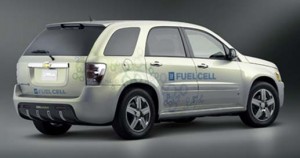


GM insists it is at the forefront of fuel cell development - but it claims it will have to drop its research work without some federal funding.
General Motors officials are hinting that their research work on what many experts believe will be the ultimate clean automotive technology could be at risk – unless, that is, the federal government kicks in with yet more money.
Insiders tell TheDetroitBureau.com that GM has already spent over $1 billion to develop its fuel cell technology. But despite the company’s belief that it has an edge on competitors like Toyota and Daimler AG, it warns it doesn’t have the cash on hand, after its recent bankruptcy, to keep up the necessary pace.
“The program has not slowed down at all,” Larry Burns, GM’s retiring vice president of research, told USA Today, in a report on the fuel cell program. “The issue is, going forward, do we have sufficient money to operate at that rate?”
The challenge for GM, like its competitors, is how to justify spending so much money on a project that could take decades to pay out.
Fuel cells are a surprising old technology, the basic concept dating back to the mid-19th Century, but their first practical application came during the Apollo space program, when the devices were used to provide electrical power during the long flight.
At its most basic, a fuel cell forces hydrogen, the lightest element, through a mesh coated with rare metals like platinum. There the gas combines with oxygen to produce water – and generate heat and electric current as a byproduct. That power can be used to run the motors of an electric vehicle in place of a battery.
While the basic physics are well understood, the challenge is to reduce the size and weight of a fuel cell, increase its power and durability, and, perhaps most significant of all, to sharply reduce its cost. The Apollo devices cost millions, and even in mass production, today’s fuel cell designs would be non-competitive non-starters when used as alternatives to the time-tested internal combustion engine.
Honda, one of General Motors’ most ambitious competitors, has actually been “selling” a hydrogen car of its own, but in extremely limited numbers. For their part, GM officials, including Burns and former CEO Rick Wagoner, had until recently hoped to begin producing a commercially-viable fuel cell vehicle, or FCV, soon after the turn of the decade.
That target has slipped as the cash-strapped automaker has shifted focus to nearer-term technologies, such as the Volt, a so-called plug-in hybrid. But GM still remains as ambitious as anyone to commercialize a technology many believe could become the way of the automotive future sometime after 2020.
But for the long-troubled U.S. maker to get there, said Burns, it could require anywhere from $50 million to $70 million in funding from the government. The Department of Energy was authorized, late last year, to help support advanced research programs aimed at developing high-mileage, low-emission technologies, such as fuel cells. And there are other potential funding sources, but the Obama Administration’s Secretary of Energy, Steven Chu, recently cut $100 million out of the $168 million previously set aside for hydrogen research, shifting it to support battery vehicles.
Burns told USA Today that GM must continue hydrogen funding to stay ahead of Japanese, South Korean and German automakers that have their own programs, noting that, “The design we’re working on right now would just knock your socks off.” But to maintain leadership, said the outgoing executive, “It has put us in a position where we are going to have to rely on the federal government.”

This March Ford finally came to their senses and dropped their Fuel Cell program after how many millons spent? Now GM follows suit. Perhaps this would be a different story if there was really enough recoverable platinum in the world to make the number of fuel cells needed by the worlds fleet.
Who are the supposed experts that are refered to in this piece who keep claiming that fuel cells will be the ultimate clean automotive technology?
Hasn’t anyone ever read the 2005 Oak Ridge National Laboratory’s report on hydrogen by Dr. Greene?
Between the platinum issue and the Greene report isn’t it only logical to put the entire fuel cell fiasco to rest once and for all?
I think H2 Fuel Cell technology has many challenges which are “pre-competitive” research that it would seem to make more sense for Fuel Cell stack research to be done in various consortium (gov-industry, corporate, international). GM will have an excellent electrified vehicle powertrain architecture to leverage with the Volt and Voltec. If they continue FCV research, their focus should be on the fuel cell stack durability and cost. GM could use the Volt platform to cost reduce and refine the rest of the electrified vehicle. Also, can someone point me to a well to wheels energy and CO2 analysis that shows H2 FCV have an advantage over PHEVs/eREVs? The credible studies seem to indicate that instead of using electricity to create H2 from water, then transporting/distributing/using the H2 it’s better to simply ship the electricity through the grid and use it in a PHEV. Others advocate using NatGas as a source for H2, but this doesn’t help with the retail H2 distribution problem sufficiently nor reduce CO2 as much as a PHEV powered by nuclear/wind/solar.
Syeven Bloxham please post a link to the report by Dr. Greene.